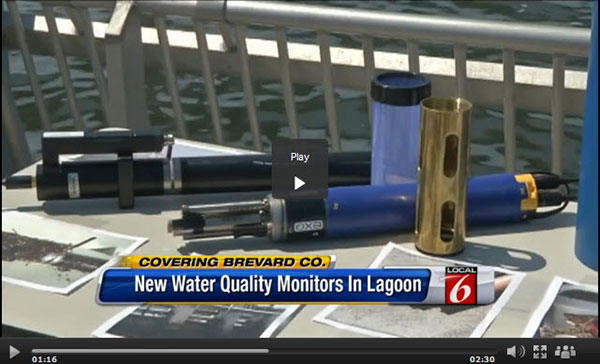Monitoring a Florida Lagoon's Water Quality Health
A $1 million network of water-quality sensors will for the first time take the real-time pulse of Indian River Lagoon algae blooms and pollution.
Florida provided $746,000 for 15 water-quality sensors, five of which are already in the lagoon. Others will go in springs and other Central Florida waters. And Brevard County plans to install three other real-time monitors, using $380,000 in state money.
"Our economic health is dependent on the health of this lagoon," Douglas Bournique, a governing board member of the St. Johns River Water Management District, told a few dozen dignitaries gathered Friday at the Veterans Memorial Fishing Pier in Titusville to celebrate the new sensors.
The water management district maintains the monitors and provides the data live on the district's website.
Previously, researchers had to grab water samples by hand, whenever they could. The new monitoring system marks the first time scientists will have available a continuous stream of hourly and daily data about nutrients and other factors impacting the lagoon.
Dolphins frolicked near the center of the lagoon as the featured speakers described the sensors, the lagoon's importance, and the work ahead toward a healthy lagoon.
"This is just a piece of the puzzle," said Rep. Steve Crisafulli, R-Merritt Island.
The new sensors will measure nitrate, phosphate, pH, dissolved oxygen, chlorophyll, conductivity, temperature, and other parameters.
A cellular modem sends the data to software that feeds the information to the district's website.
Lagoon managers mostly want to know how nutrients enter, move around and build up in the lagoon and lead to algae blooms. That information will help to identify future stormwater and other projects to improve water quality.
Spikes in the data — such as chlorophyll — also might provide early warning of potentially harmful algae blooms.
The focus is solutions, not just research, officials said.
The probes are at five locations: Mosquito Lagoon, Veterans Memorial Bridge in Titusville, U.S. 192 Causeway in Melbourne, State Road 520 Causeway between Cocoa Beach and Merritt Island, and the 17th Street Bridge in Vero Beach.
Widespread algae blooms in 2011, followed by brown tide blooms in 2012 and 2013, clouded out 47,000 acres of seagrasses, a 60 percent reduction.
Although the cause cannot be linked to any one factor, district officials say excess nitrogen and phosphorus in the lagoon likely played a role.
The new water sensors are part of a larger, multi-agency effort to gather more data and identify projects to improve the lagoon's health.
This year, the legislature also allocated $380,000 to Brevard to have a small conservation group in Fort Pierce test for toxic hot spots that could be dredged to improve the lagoon.
The Ocean Research and Conservation Association (ORCA) will develop real-time data to map what's killing lagoon seagrass and wildlife.
The project includes having ORCA test sediment using a technique that tests how bacteria react to toxins.
Brevard wants to know more about the exchange of pollutants between Mosquito Lagoon, the northern Indian River Lagoon, the Banana River, and the central lagoon.
So they plan to put ORCA's "Kilroy" devices at Haulover Canal, Dragon Point, and the U.S. 192 Causeway.
Brevard also received $10 million from the state this year: $9 million to dredge out lagoon muck and $1 million for the Florida Institute of Technology to study the impacts.
Bournique highlighted the need to store more fresh water on land, rather than allowing it to flow to the lagoon from large canals dug decades ago to drain the land for farming and development.
"We're water-rich. We're just putting it in the wrong place — this lagoon," Bournique said.
What are the lagoon sensors?
Florida Department of Environmental Protection provided $746,000 for 15 water sensors, five of which are located in the lagoon.
- Suna V2 nitrate probes will measure nitrogen concentration in the form of nitrate.
- Cycle-PO4 in situ meters will measure phosphorus in the form of soluble reaction phosphate.
- Nutrient probes will be paired with multiparameter YSI EXO sondes to collect field parameters (pH, dissolved oxygen (DO), conductivity, temperature).
- The probes will be deployed at five locations: Mosquito Lagoon, Veterans Memorial Bridge in Titusville, U.S. 192 Causeway in Melbourne, SR 520 Causway, 17th Street Bridge in Vero.
Monitors will be integrated into the District telemetry network and are available live on the District's website: webapub.sjrwmd.com. That takes you to a map. Choose "Indian River Lagoon" and the water quality parameters you want to see, then click on the small red circle that indicates the monitor of interest, then click on "view graph."
Source: St. Johns River Water Management DistrictView original article at Florida Today.Contact Jim Waymer at 242-3663 or jwaymer@floridatoday.com.

Additional Blog Posts of Interest:
Alaskan Flood Waters Fail to Put a Dent in YSI Water Quality Sonde
How Does Real-Time Data Save You Time?
Reduce Cost of Water Quality Program with Simple Data Acquisition